
FM-3 Programming Module Reference Manual
Tuning Parameters
Inertia Ratio
Inertia Ratio specifies the load to motor inertia ratio and has a range of 0.0 to 50.0. A value of 1.0 specifies that load inertia equals the motor inertia (1:1 load to motor inertia). The drives can control up to a 10:1 inertia mismatch with the default Inertia Ratio value of 0.0. Inertial mismatches of over 50:1 are possible if response is reduced.
The Inertia Ratio value is used to set the internal gains in the velocity and position loops, including feedforward compensation if enabled.
To calculate the Inertia Ratio value, divide the load inertia reflected to the motor by the motor inertia of the motor. Include the motor brake as a load where applicable. The resulting value should be entered as the Inertia Ratio parameter.
I R
Where:
= RLI
MRI
IR = Inertia Ratio
RLI = Reflected Load Inertia
MI = Motor Inertia
If the exact inertia is unknown, a conservative approximate value should be used. If you enter an inertia value higher than the actual inertia, the resultant motor response will tend to be more oscillatory.
If you enter an inertia value lower than the actual inertia, but is between 10 and 90 percent of the actual, the drive will tend to be more sluggish than optimum but will usually operate satisfactorily. If the value you enter is less than 10 percent of the actual inertia, the drive will have a low frequency oscillation at speed.
Friction
In the drive, this is a viscous friction parameter, characterized in terms of the rate of friction increase per 100 motor RPM. The range is 0.00 to 100.00 in units of percent continuous torque of the specified motor/drive combination. The Friction value can either be estimated or measured.
If estimated, always use a conservative (less than or equal to actual) estimate. If the friction is completely unknown, a value of zero should be used. A typical value used here would be less than one percent.
If the value entered is higher than the actual, system oscillation is likely. If the value entered is lower than the actual a more sluggish response is likely but generally results in good operation.
216
